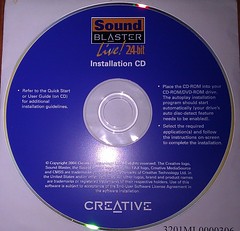Creative Sound Blaster Live 51 Cd Iso
Feb 28, 2017 Creative Sound Blaster Live 5.1 Cd Iso. 2/28/2017 0 Comments Notice: If you plan to use this guide on your site please make sure to give credit where it is due. Before reading this please note that all listings are subject to. Creative Labs Sound Card Drivers. This site maintains listings of sound card drivers available on the web, organized. Dec 28, 2018 - HACK Creative SoundBlaster Live! 5.1 Driver Disc - 56a4c31ff9. This soundcard, tho only updates.ISO ripped from an.
This article possibly contains. Please by the claims made and adding. Statements consisting only of original research should be removed. ( June 2018) () Sound Blaster Live! Is a add-on from for. Moving from ISA to PCI allowed the card to dispense with onboard memory, storing in the computer's main memory and then accessing them in real time over the bus.
This allowed for a much wider selection of, and longer playing, samples. It also included higher quality sound output at all levels, quadrophonic output, and a new synthesizer with 64 sampled voices. Was introduced in August 1998 and variations on the design remained Creative's primary sound card line into the 2000s. Sound Blaster Live! Value / Compaq / Intel / IBM / NEC Sound Blaster Live!
(August 1998) saw the introduction of the EMU10K1 audio processor. Manufactured in a 0.35µm 3-metal-layer CMOS process, it is a 2.44 million transistor rated at 1000.
The EMU10K1 featured hardware acceleration for and EAX 1.0 and 2.0 (), along with a high-quality 64-voice MIDI and an integrated chip for real-time digital audio effects. A major design change from its predecessor (the EMU8000) was that the EMU10K1 used system memory, accessed over the bus, for the wavetable samples, rather than using expensive on-board memory. This was possible at this point because systems were being equipped with far more RAM than previously, and PCI offered far faster and more efficient data transfer than the old bus. The integrated FX8010 was a 32-bit programmable processor with 1 kilobyte of instruction memory. It provided real-time postprocessing effects (such as,, or ).
This capability let users select a pre-defined listening environment from a control-panel application (concert hall, theater, headphones, etc.) It also provided hardware-acceleration for EAX, Creative's environmental audio technology. The Effect algorithms were created by a development system that integrated into Microsoft Developer Studio. The effects were written in a language similar to, and compiled into native FX8010 object code by its compiler, fxasm. The Sound Blaster Live!
Featured higher audio quality than previous Sound Blasters, as it processed the sound digitally at every stage, and because of its greater chip integration that reduced the analog signal losses of older, larger cards. Unfortunately, digital processing brought some limitations. The DSP had an internal fixed of 48 kHz, a standard clock, meaning that the EMU10K1 always captured external audio-sources at the 48 kHz, then performed a sample-rate conversion on the 48 kHz waveform to the output the requested target rate (such as 44.1 kHz or 32 kHz). This rate-conversion step introduced into the downsampled output.
Mortal kombat unchained cheats. However, the rate-conversion was only applied when the audio signal was passed through the effects engine. The SB/Live had great difficulty with resampling audio-CD source material (44.1 kHz) without introducing audible distortion. Creative addressed this concern by recommending audio-recording be performed exclusively at 48 kHz, and use third-party software to handle the desired sample-rate conversion, to avoid using the EMU10K1's sample-rate conversion. Sound Blaster Live!
Supported multi-speaker output, initially up to a 4-speaker setup. The software referred to this as a '4.1' setup, meaning 4 satellites and a. While this is the case, the subwoofer is not on a separate output as it is with 5.1 and higher audio. Instead, a (crossover) within the speaker system removes high and midrange frequencies from the sound card's output for the subwoofer. Games see a '4.1' speaker system as because DirectSound itself offers no subwoofer output in this configuration. This is not limited to Creative sound cards;,,, and other manufacturers have made cards that use four-speaker output in the same fashion.

Later versions of the Live!, usually called Live! 5.1, offered 5.1-channel support which adds a speaker and subwoofer output, most useful for movie watching where 5.1 is decoded. Implemented legacy support via 's DOS program.
Creative acquired Ensoniq in 1998 and, as part of the deal, made use of this highly-compatible sound card emulator with their newer cards. In fact, the Live! Uses '.ecw' (Ensoniq Concert Wavetable) files for the wavetable emulation in DOS. The program enables support for many standards, such as Sound Blaster 16,, (OPL3), among others. Sound Blaster Live! Was the first sound card from Creative with the 'What U Hear' recording input channel.